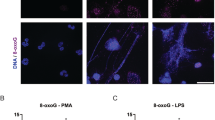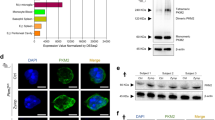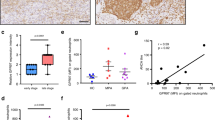Abstract
The production of reactive oxygen species (ROS) by neutrophils has a vital role in defence against a range of infectious agents, and is driven by the assembly of a multi-protein complex containing a minimal core of five proteins: the two membrane-bound subunits of cytochrome b558 (gp91phox and p22phox) and three soluble factors (GTP–Rac, p47phox and p67phox (refs 1, 2). This minimal complex can reconstitute ROS formation in vitro in the presence of non-physiological amphiphiles such as SDS. p40phox has subsequently been discovered as a binding partner for p67phox (ref. 3), but its role in ROS formation is unclear. Phosphoinositide-3-OH kinases (PI(3)Ks) have been implicated in the intracellular signalling pathways coordinating ROS formation4,5 but through an unknown mechanism. We show that the addition of p40phox to the minimal core complex allows a lipid product of PI(3)Ks, phosphatidylinositol 3-phosphate (PtdIns(3)P), to stimulate specifically the formation of ROS. This effect was mediated by binding of PtdIns(3)P to the PX domain6 of p40phox. These results offer new insights into the roles for PI(3)Ks and p40phox in ROS formation and define a cellular ligand for the orphan PX domain.
This is a preview of subscription content, access via your institution
Access options
Subscribe to this journal
Receive 12 print issues and online access
$209.00 per year
only $17.42 per issue
Buy this article
- Purchase on Springer Link
- Instant access to full article PDF
Prices may be subject to local taxes which are calculated during checkout



Similar content being viewed by others
References
Segal, A. W. & Abo, A. Trends Biochem. Sci. 18, 43–47 (1993).
Wientjes, F. B. & Segal, A. W. Semin. Cell. Biol. 6, 357–365 (1995).
Wientjes, F. B., Hsuan, J. J., Totty, N. F. & Segal, A. W. Biochem.J. 296, 557–562 (1993).
Baggiolini, M. et al. Exp. Cell Res. 169, 408–418 (1987).
Condliffe, A. M. & Hawkins, P. T. Nature 404, 135–137 (2000).
Ponting, C. P. Protein Sci. 5, 2353–2357 (1996).
Pacold, M. E. et al. Cell 103, 931–943 (2000).
Knoller, S., Shpungin, S. & Pick, E. J. Biol. Chem. 266, 2795–2804 (1991).
Stenmark, H. & Aasland R. J. Cell Sci. 112, 4175–4183 (1999).
Condliffe, A. M., Hawkins, P. T., Stephens, L. R., Haslett, C. & Chilvers, E. R. FEBS Lett 439, 147–151 (1998).
Scianimanico, S. et al. Cell Microbiol. 1, 19–32 (1999).
Desjardins, M. Trends Cell Biol. 5,184–186 (1995).
Painter, G. F. et al. J. Chem. Soc. Perkin Trans. 1, 923–935 (1999).
Stephens, L. et al. Cell 89, 105–114 (1997).
Erdjument-Bromage, H. et al. J. Chromatogr. 826, 167–181 (1998).
Geromanos, S., Freckleton, G. & Tempst, P. Anal. Chem. 72, 777–790 (2000).
Mann, M., Højrup, P. & Roepstorff P. Biol. Mass Spectrom. 22, 338–345 (1993).
Abo, A., Boyhan, A., West, I., Thrasher A. J., & Segal, A. W. J. Biol. Chem. 267, 16767–16770 (1992).
Diebold, B. A. & Bokoch, G. M. Nature Immunol. 2, 211–215 (2001).
Acknowledgements
We thank A. Hall for GST–p67phox and GST–47phox bacterial expression plasmids, C. Erneux for SHIP-1 cDNA, and F. A. Norris for the inositol polyphosphate 4-phosphatase cDNA. We also acknowledge the Isaac Newton Trust for a contribution towards the Biacore 3000 machine. K.E.A. is a Beit Memorial Fellow, and P.T.H. is a BBSRC Advanced Research Fellow. This work was supported by the BBSRC, by the MRC (studentship to C.D.E.) and by a National Cancer Institute core grant (to P.T.).
Author information
Authors and Affiliations
Corresponding author
Supplementary information
Download plugins
Method S1 Purification and assaying of cytosolic factors from pig neutrophil cytosol. (PDF 57 kb)
Method S2 Assay of phosphoinositide phosphatase activities of SHIP-1 and Inositol polyphosphate 4-phosphatase mutants
Figure S1 Purification of three factors allowing PtdIns(3,4,5)P3 to stimulate ROS production.
Figure S2 SHIP-1 and Inositol polyphosphate 4-phosphatase lipid phosphatase activity are required for PtdIns(3,4,5)P3 stimulated ROS formation.
Rights and permissions
About this article
Cite this article
Ellson, C., Gobert-Gosse, S., Anderson, K. et al. PtdIns(3)P regulates the neutrophil oxidase complex by binding to the PX domain of p40phox. Nat Cell Biol 3, 679–682 (2001). https://doi.org/10.1038/35083076
Received:
Revised:
Accepted:
Published:
Issue Date:
DOI: https://doi.org/10.1038/35083076
This article is cited by
-
Classification of the human phox homology (PX) domains based on their phosphoinositide binding specificities
Nature Communications (2019)



